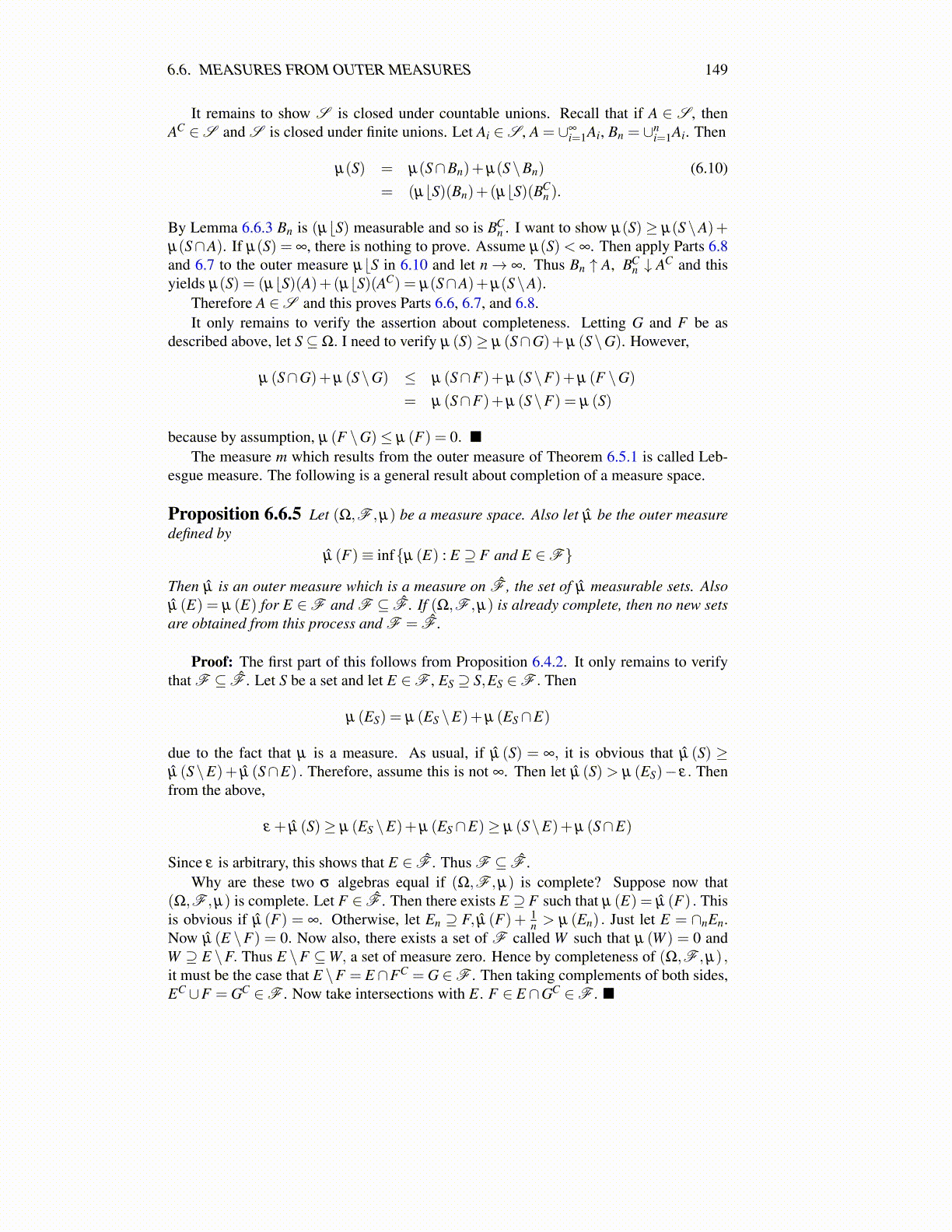
6.6. MEASURES FROM OUTER MEASURES 149
It remains to show S is closed under countable unions. Recall that if A ∈ S , thenAC ∈S and S is closed under finite unions. Let Ai ∈S , A = ∪∞
i=1Ai, Bn = ∪ni=1Ai. Then
µ(S) = µ(S∩Bn)+µ(S\Bn) (6.10)= (µ⌊S)(Bn)+(µ⌊S)(BC
n ).
By Lemma 6.6.3 Bn is (µ⌊S) measurable and so is BCn . I want to show µ(S) ≥ µ(S \A)+
µ(S∩A). If µ(S) = ∞, there is nothing to prove. Assume µ(S)< ∞. Then apply Parts 6.8and 6.7 to the outer measure µ⌊S in 6.10 and let n→ ∞. Thus Bn ↑ A, BC
n ↓ AC and thisyields µ(S) = (µ⌊S)(A)+(µ⌊S)(AC) = µ(S∩A)+µ(S\A).
Therefore A ∈S and this proves Parts 6.6, 6.7, and 6.8.It only remains to verify the assertion about completeness. Letting G and F be as
described above, let S⊆Ω. I need to verify µ (S)≥ µ (S∩G)+µ (S\G). However,
µ (S∩G)+µ (S\G) ≤ µ (S∩F)+µ (S\F)+µ (F \G)
= µ (S∩F)+µ (S\F) = µ (S)
because by assumption, µ (F \G)≤ µ (F) = 0. ■The measure m which results from the outer measure of Theorem 6.5.1 is called Leb-
esgue measure. The following is a general result about completion of a measure space.
Proposition 6.6.5 Let (Ω,F ,µ) be a measure space. Also let µ̂ be the outer measuredefined by
µ̂ (F)≡ inf{µ (E) : E ⊇ F and E ∈F}
Then µ̂ is an outer measure which is a measure on F̂ , the set of µ̂ measurable sets. Alsoµ̂ (E) = µ (E) for E ∈F and F ⊆ F̂ . If (Ω,F ,µ) is already complete, then no new setsare obtained from this process and F = F̂ .
Proof: The first part of this follows from Proposition 6.4.2. It only remains to verifythat F ⊆ F̂ . Let S be a set and let E ∈F , ES ⊇ S,ES ∈F . Then
µ (ES) = µ (ES \E)+µ (ES∩E)
due to the fact that µ is a measure. As usual, if µ̂ (S) = ∞, it is obvious that µ̂ (S) ≥µ̂ (S\E)+ µ̂ (S∩E) . Therefore, assume this is not ∞. Then let µ̂ (S) > µ (ES)− ε. Thenfrom the above,
ε + µ̂ (S)≥ µ (ES \E)+µ (ES∩E)≥ µ (S\E)+µ (S∩E)
Since ε is arbitrary, this shows that E ∈ F̂ . Thus F ⊆ F̂ .Why are these two σ algebras equal if (Ω,F ,µ) is complete? Suppose now that
(Ω,F ,µ) is complete. Let F ∈ F̂ . Then there exists E ⊇ F such that µ (E) = µ̂ (F) . Thisis obvious if µ̂ (F) = ∞. Otherwise, let En ⊇ F, µ̂ (F)+ 1
n > µ (En) . Just let E = ∩nEn.Now µ̂ (E \F) = 0. Now also, there exists a set of F called W such that µ (W ) = 0 andW ⊇ E \F. Thus E \F ⊆W, a set of measure zero. Hence by completeness of (Ω,F ,µ) ,it must be the case that E \F = E ∩FC = G ∈F . Then taking complements of both sides,EC ∪F = GC ∈F . Now take intersections with E. F ∈ E ∩GC ∈F . ■